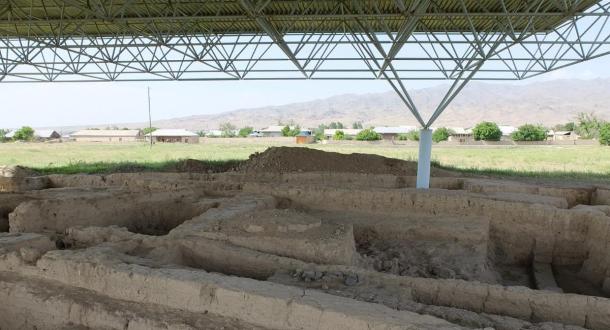🔴 Website 👉 https://u-s-news.com/
Telegram 👉 https://t.me/usnewscom_channel
Around 5,500 years ago, a large settlement of farmers, artisans and miners who traded around Asia along the proto-Silk Road sprang up in what is now Tajikistan. For some reason we may never know, the oldest and most advanced city in that part of the world collapsed about 1,600 years later, leaving remnants of a sophisticated community that was first unearthed in the 1970s.
The ruins of that community we now call Sarazm. It came to light in 1970 when a resident of a nearby village found a small bronze ax-adze while digging. He waited six years to inform an archaeologist in nearby Panjakent, after which excavations began.
Sarazm Culture: Not Far Behind Sumer and Harappa
When Sarazm was established, the first civilized states of Harappa in India and Sumer in Mesopotamia were already thriving. But Sarazm was not far behind. It was a pivotal city between hunting and gathering, and civilization.
The place was ideal for development, being in northwestern Tajikistan on a plain conducive to agriculture near the Zerafshan River. Spectacular mountains rise to the south, giving opportunities for mining and irrigation.
At the height of its development. Sarazm had about 3,000 residents, says a UNESCO report that nominated the site for World Heritage Site status. It is the first UNESCO World Heritage site in Tajikistan.
Ancient Sarazm Granary and Religious Structures
Sarazm culture had communal religious structures, a palace and a communal granary. There is no evidence of which gods they worshiped, but the fact that they had temples points to advanced cultural development. And we can only speculate about who lived in the palace.
Archaeologists, digging from 1 to 1.5 meters (3.3 to 5 ft) down, found several layers of prehistoric activity, including dwellings, irrigation systems, and workshops, says a Tajikistan tourism site run by an NGO. They also found “religious structures with round altars characteristic of the Bronze Age – the oldest Pre-Zoroastrian monument of the fire cult.”
Digging continues today at what archaeologists call the largest Bronze Age settlement in Central Asia. Digs have revealed that buildings were made of wood, clay and adobe. Engineering, which was pretty advanced for its time, showed sophisticated lighting and ventilation worked into the structures.
The homes consisted of multiple rooms with a living room, kitchen, storage area and a courtyard enclosed by a fence where the people produced crafts. Multiple families shared residential complexes. Houses also had altars for religious purposes.
The digs at Sarazm have revealed a rich and fascinating life for these prehistoric residents who lived along the proto-Silk Road. (Public Domain)
A Treasury, Including Metal Tools And Jewels
The man who found the ax head in 1970 was not the only resident to find objects, says the Tajikistan tourism site. Others found objects made of bronze and stone, pottery and ceramic fragments. The residents handed these objects over to the authorities, who began digging.
A decorative flower from the religious structure (© Marie-Lan Nguyen/CC BY 4.0)
The archaeologists found many artifacts. Among the objects were processed metals, including tin, cast bronze and forged copper fashioned into knives and spears, says the UNESCO report. They also found chisels used in fine work on bone, stone and metal. The residents also worked in lead, gold and silver. Since this was a Copper Age and Bronze Age village, no iron was found.
Experts believe the people of Sarazm ran the largest trading community in Central Asia, says a Tajikistan government report. The mining of tin may have been a lucrative trade item for the city’s residents as it was a metal used to make bronze, which people in other communities started producing.
The digs turned up small bits of quartz, lapis lazuli from Badakhshan and turquoise from Ferghana. They also found jewelry made of silver and gold.
The residents had clay stoves for firing pottery. They made pottery by connecting strips of clay. A potter’s wheel was unearthed, but scientists believe it was not used much.
Spindle whorls and bone tools attest that the community weaved cloth, worked leather and made shoes. Archaeologists also have found marble goblets and cups, and evidence of bows and arrows.
Other objects show that Sarazm had contact with India, Afghanistan, Iran and other parts of Central Asia.
Artifacts unearthed in Sarazm include pottery shards, ax heads, bone tools and bronze spear and arrowheads. (Bertramz/CC BY-SA 3.0)
Farming And Cattle-Raising
Scientists examining the site found evidence of wheat and barley production. The barley was similar to that found in ancient sites in China and Pakistan. The remains of wild fruits give evidence that the residents engaged in foraging, says a scholarly report in the Journal of Human Paleoecology. Digs uncovered Russian olives, sea buckthorn berries, hackberries, capers and pistachios.
The site had advanced irrigation technology. One of the two irrigation systems reveals that they farmed in the plains near the river. The other system involved terraced irrigation where water from the mountains was collected. The community herded cattle, and the residents also did some hunting.
Sarazm is Abandoned
The people abandoned Sarazm around 2000 BC when other settlers from the Andronovo culture of nearby Kazakhstan moved in. Settlers re-established the city around 1500 BC and engaged in mining, copper production for the surrounding region, and turquoise collection.
The village of Sarazm was the first and largest of its kind in the region to engage in farming, metallurgy and long-distance trade. Sarazm culture had all the hallmarks of civilization except a writing system. It was one of the oldest towns in the world.
Top image: Cylinder seal, 4th millennium BC. Source: Public Domain
By Mark Miller



